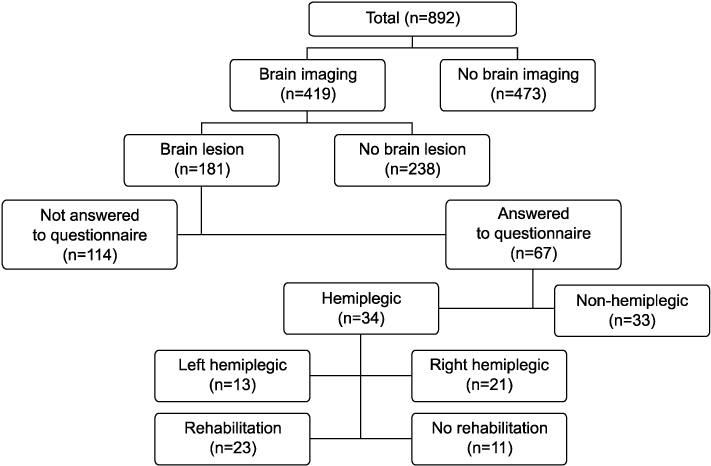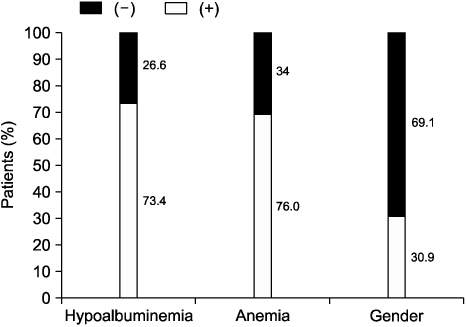Brain Neurorehabil.
2011 Sep;4(2):126-131. 10.12786/bn.2011.4.2.126.
Analysis of Stroke Patients with Hip Fracture
- Affiliations
-
- 1Department of Rehabilitation Medicine, School of Medicine, Ewha Womans University, Korea. blackhair98@hanmail.net
- 2Department of Orthopaedic Surgery, School of Medicine, Ewha Womans University, Korea.
- KMID: 2048467
- DOI: http://doi.org/10.12786/bn.2011.4.2.126
Abstract
OBJECTIVE
To investigate the specific features of stroke patients with hip fracture, and the correlation of fracture occurrence with rehabilitation after stroke onset. METHOD: We retrospectively analyzed 181 stroke patients in a total of 892 patients who underwent an operation due to hip fracture. The assessment factors consists of age, the location of brain lesion, bone marrow density, body mass index, the presence of diabetes mellitus and anemia, laboratory findings of serum albumin, calcium and phosphate. We also analyzed subject's dominant hand side, experience of rehabilitation, and the duration between stroke onset and occurrence of hip fracture.
RESULTS
Among 181 patients (56 male, 125 female), most common location of the brain lesion was the subcortex. About 70% of patients had osteoporosis, anemia and hypoalbuminemia. Among 34 hemiplegic patients, most of them had hip fracture on hemiplegic side (91.2%). The duration between stroke onset and occurrence of hip fracture of the patients who had experience of rehabilitation after stroke was longer than that of the patients without rehabilitation experience (p<0.05).
CONCLUSION
Woman, osteoporosis, anemia and hypoalbuminemia are correlated with the hip fracture in stroke patient. The hip fracture of the stroke patient who did not have rehabilitation experience occurred earlier. The rehabilitation therapy including education for prevention of falling may be helpful to stroke patients with these factors.
Keyword
MeSH Terms
Figure
Reference
-
1. Willig R, Luukinen H, Jalovaara P. Factors related to occurrence of hip fracture during a fall on the hip. Public Health. 2003. 117:25–30.2. Youm T, Aharonoff G, Zuckerman JD, Koval KJ. Effect of previous cerebrovascular accident on outcome after hip fracture. J Orthop Trauma. 2000. 14:329–334.3. Kim JS, Chang YA. Ambulatory outcome after hip fractures in patients with cerebrovascular accident. J Korean Acad Rehabil Med. 2000. 24:410–415.4. Stolee P, Poss J, Cook RJ, Byrne K, Hidres JP. Risk factors for hip fracture in older home care clients. J Gerontol A Biol Sci Med Sci. 2009. 64:403–410.5. Nordström A, Eriksson M, Stegmayr B, Gustafson Y, Nordström P. Low bone mineral density is an independent risk factor for stroke and death. Cerebrovasc Dis. 2010. 29:130–136.6. Khan S, Leung E, Jay WM. Stroke and visual rehabilitation. Top Stroke Rehabil. 2008. 15:27–36.7. Jannink MJ, Aznar M, de Kort AC, van de Vis W, Veltink P, van der Kooij H. Assessment of visuospatial neglect in stroke patients using virtual reality: a pilot study. Int J Rehabil Res. 2009. 32:280–286.8. Sato Y, Iwamoto J, Kanoko T, Satoh K. Residronate therapy for prevention of hip fracture after stroke in elderly women. Neurology. 2005. 64:811–816.9. Sato Y, Honda Y, Iwamoto J, Kanoko T, Satoh K. Effect of folate and mecobalamin on hip fractures in patients with stroke: a randomized controlled trial. JAMA. 2005. 293:1082–1088.10. Sato Y, Iwamoto J, Kanoko T, Satoh K. Low-dose vitamin D prevents muscular atrophy and reduces falls and hip fractures in women after stroke: a randomized controlled trial. Cerebrovasc Dis. 2005. 20:187–192.11. Kang MJ, Kim MK, Lee KM, Kim KR. Epidemiologic study of fracture in stroke patients. J Korean Acad Rehabil Med. 2000. 24:14–20.12. Kim HS, Lee KW, Sung DH, Hwang JH, Kim TU. Posturographic characteristics of lesion site in stroke patients. J Korean Acad Rehabil Med. 2000. 24:363–369.13. Myung H, Lee SB, Roh JK, Yoon BW, Lee WY, Kim MH, Kim JH, Wie BA, Chung CS, Kwon OS. Current status of cerebrovascular disease in Korea. J Korean Neurol Assoc. 1989. 7:179–187.14. Cauley JA, Lui LY, Genant HK, Salamone L, Browner W, Fink HA, Cohen P, Hillier T, Bauer DC, Cummings SR. Risk factors for severity and type of the hip fracture. J Bone Miner Res. 2009. 24:943–955.15. Lane NE. Epidemiology, etiology, and diagnosis of osteoporosis. Am J Obstet Gynecol. 2006. 194:S3–S11.16. Ribot C, Tremollieres F, Pouilles JM, Bonneu M, Germain F, Louvet JP. Obesity and postmenopausal bone loss: the influence of obesity on vertebral density and bone turnover in postmenopausal women. Bone. 1987. 8:327–331.17. Rosen CJ, Klibanski A. Bone, fat, and body composition: evolving concepts in the pathogenesis of osteoporosis. Am J Med. 2009. 122:409–414.18. Duh MS, Mody SH, Lefebvre P, Woodman RC, Buteau S, Piech CT. Anaemia and the risk of injurious falls in a community-dwelling elderly population. Drugs Aging. 2008. 25:325–334.19. Gerber V, Krieg MA, Cornuz J, Guigoz Y, Burckhardt P. Nutritional status using the Mini Nutritional Assessment questionnaire and its relationship with bone quality in a population of institutionalized elderly women. J Nutr Health Aging. 2003. 7:140–145.20. Roth EJ, Lovell L, Harvey RL, Heinemann AW, Semik P, Diaz S. Incidence of and risk factors for medical complications during stroke rehabilitation. Stroke. 2001. 32:523–529.21. Korea Centers for Disease Control and Prevention. National Health Statistics 2008. 2008. Seoul: Korea Centers for Disease Control and Prevention;52–53.22. Schwartz AV. Diabetes Mellitus: Does it affect bone? Calcif Tissue Int. 2003. 73:515–519.
- Full Text Links
- Actions
-
Cited
- CITED
-
- Close
- Share
- Similar articles
-
- Ambulatory Outcome after Hip Fractures in Patients with Cerebrovascular Accident
- Intertrochanteric fracture associated with posterior hip dislocation
- Orthopaedic Surgical Treatment of Hip Fractures
- Total hip arthroplasty in unreduced fracture dislocation of the hip
- Second hip fracture in Hong Kong e Incidence, demographics, and mortality




